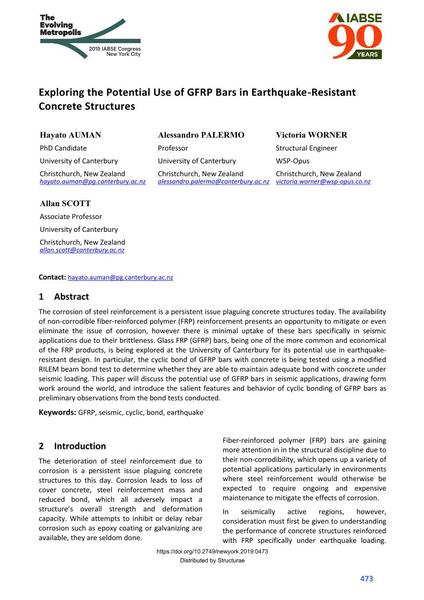Exploring the Potential Use of GFRP Bars in Earthquake-Resistant Concrete Structures

|
|
|||||||||||
Détails bibliographiques
| Auteur(s): |
Hayato Auman
(University of Canterbury)
Alessando Palermo (University of Canterbury) Victoria Worner (University of Canterbury) Allan Scott (University of Canterbury) |
||||
|---|---|---|---|---|---|
| Médium: | papier de conférence | ||||
| Langue(s): | anglais | ||||
| Conférence: | IABSE Congress: The Evolving Metropolis, New York, NY, USA, 4-6 September 2019 | ||||
| Publié dans: | The Evolving Metropolis | ||||
|
|||||
| Page(s): | 473-478 | ||||
| Nombre total de pages (du PDF): | 6 | ||||
| DOI: | 10.2749/newyork.2019.0473 | ||||
| Abstrait: |
The corrosion of steel reinforcement is a persistent issue plaguing concrete structures today. The availability of non-corrodible fiber-reinforced polymer (FRP) reinforcement presents an opportunity to mitigate or even eliminate the issue of corrosion, however there is minimal uptake of these bars specifically in seismic applications due to their brittleness. Glass FRP (GFRP) bars, being one of the more common and economical of the FRP products, is being explored at the University of Canterbury for its potential use in earthquake- resistant design. In particular, the cyclic bond of GFRP bars with concrete is being tested using a modified RILEM beam bond test to determine whether they are able to maintain adequate bond with concrete under seismic loading. This paper will discuss the potential use of GFRP bars in seismic applications, drawing form work around the world, and introduce the salient features and behavior of cyclic bonding of GFRP bars as preliminary observations from the bond tests conducted. |
||||
| Mots-clé: |
tremblement de terre
|
||||
